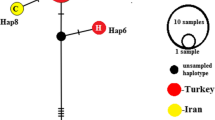Abstract
Sixty-six isolates of larval stage of Echinococcus granulosus, a known pathogenic parasite of man and animals were collected from cattle, buffalo, sheep, and goats. Single-stranded conformation polymorphism (SSCP) for analysis of variation after denaturation of amplicon of intron of actin II (ACTII) revealed six SSCP phenotypes. Intron portion was analyzed considering introns-early and introns-late theories. Isolates belonging to different conformers were further screened for mitochondrial ATPase subunit 6 (ATP6) and NADH dehydrogenase subunit II (nadII) genotypes. Assignment of each isolate to its specific strain was achieved after comparing with standard genotypes of E. granulosus. Variants deduced by nuclear targets did not match with mitochondrial haplotypes. A possible explanation for this observation can be attributed toward interspecific hybridization since cross-fertilization occurs less frequently in hermaphrodite organisms. A phylogenetic tree drawn on the basis of predicted aminoacid sequence of ATP6 and nadII revealed two distinct clusters i.e. E. granulosus sensu stricto and E. ortleppi/cattle strain (EG5). To the best of our knowledge, this is the first report of genetic characterization of two distinct ATP6 and nadII genotypes of zoonotic importance living in sympatry.



Similar content being viewed by others
References
Arnaud-Haond S, Bonhomme F, Blanc F (2003) Large discrepancies in differentiation of allozymes, nuclear and mitochondrial DNA loci in recently founded Pacific populations of the pearl oyster Pinctdata margaritifera. J Evol Biol 16:388–389. doi:10.1046/j.1420-9101.2003.00549.x
Bart JM, Bardonnet K, Elfegoun MC, Dumon H, Dia L, Vuitton DA et al (2004) Echinococcus granulosus strain typing in North Africa: comparison of eight nuclear and mitochondrial DNA fragments. Parasitology 128:229–234. doi:10.1017/S0031182003004359
Bart JM, Morariu S, Knapp J, Ilie MS, Pitulescu M, Anghel A et al (2006) Genetic typing of Echinococcus granulosus in Romania. Parasitol Res 98:130–137. doi:10.1007/s00436-005-0015-9
Bhattacharya D, Bera AK, Bera BC, Maity A, Das SK (2007) Genotypic characterisation of Indian cattle, buffalo and sheep isolates of Echinococcus granulosus. Vet Parasitol 143:371–374. doi:10.1016/j.vetpar.2006.09.007
Bhattacharya D, Pan D, Bera AK, Konar A, Das SK (2008) Mutation scan screening of Echinococcus granulosus isolates of Indian origin. Vet Res Commun 32(6):427–432
Boissinot S, Boursot P (1997) Discordant phylogeographic patterns between the Y chromosome and mitochondrial DNA in the house mouse: selection on the Y chromosome? Genetics 146:1019–1034
Capuano F, Rinaldi L, Maurelli MP, Perugini AG, Veneziano V, Garippa G et al (2006) Cystic echinococcosis in water buffaloes: epidemiological survey and molecular evidence of ovine (G1) and buffalo (G3) strains. Vet Parasitol 137:262–268. doi:10.1016/j.vetpar.2006.01.016
Haag KL, Araujo AM, Gottstein B, Siles-Lucas M, Thompson RCA, Zaha A (1999) Breeding systems in Echinococcus granulosus (Cestoda; Taeniidae): selfing or outcrossing? Parasitology 118:63–71. doi:10.1017/S0031182098003485
Haag KL, Ayala FJ, Kamenetzky L, Gutierrez AM, Rosenzvit M (2004) Livestock trade history, geography, and parasite strains: the mitochondrial genetic structure of Echinococcus granulosus in Argentina. J Parasitol 90:234–239. doi:10.1645/GE-173R
Kamenetzky L, Gutierrez AM, Canova SG, Haag KL, Guarnera EA, Parra A, García GE, Rosenzvit MC (2002) Several strains of Echinococcus granulosus infect livestock and humans in Argentina. Infect Genet Evol 2(2):129–136
Lavikainen A, Lehtinen MJ, Laaksonen S, Agren E, Oksanen A, Meri S (2006) Molecular characterization of Echinococcus isolates of cervid origin from Finland and Sweden. Parasitology 133:565–570. doi:10.1017/S0031182006000667
Lemiare C, Versini JJ, Bonhonme F (2005) Maintenance of genetic differentiation across a transition zone in the sea: discordance between nuclear and cytoplasmic markers. J Evol Biol 18:70–80. doi:10.1111/j.1420-9101.2004.00828.x
Maity A, Bhattacharya D, Batabyal S, Chattopadhyay S, Bera AK, Karmakar PK (2007) Echinococcus granulosus of buffalo in India: partial characterization of excretory-secretory and germinal membrane antigen. Vet Res Commun 31:457–460. doi:10.1007/s11259-006-3275-7
Mattick JS, Gagen MJ (2001) The evolution of controlled multitask gene networks: the role of introns and other non coding RNAs in the development of complex organism. Mol Biol Evol 18:1611–1630
Nguyen HD, Yoshihama M, Kenmochi N (2006) Phase distribution of splicesomal introns: implications for intron origin. BMC Evol Biol 6:69
Sambrook J, Russel DW (2001) Molecular cloning: a laboratory manual, 3rd edn. Cold Spring Harbor Laboratory Press, New York, pp 6.28–6.30
Tamura K, Dudley J, Nei M, Kumar S (2007) MEGA4: Molecular Evolutionary Genetic Analysis (MEGA) software version 4.0. Mol Biol Evol 24:1596–1599. doi:10.1093/molbev/msm092
Thompson RCA, McManus DP (2002) Towards a taxonomic revision of the genus Echinococcus. Trends Parasitol 18:452–457. doi:10.1016/S1471-4922(02)02358-9
Varcasia A, Canu S, Lightowlers MW, Scala A, Garippa G (2006) Molecular characterization of Echinococcus granulosus strains in Sardinia. Parasitol Res 98:273–277. doi:10.1007/s00436-005-0059-x
Xiao N, Qiu J, Nakao M, Li T, Yang W, Chen X et al (2006) Echinococcus shiquicus, a new species from the Qinghai-Tibet plateau region of china: discovery and epidemiological implications. Parasitol Int 55:S233–S236. doi:10.1016/j.parint.2005.11.035
Xie T, Ho SL, Ma OCK (1997) High resolution single strand conformation polymorphism analysis using formamide and ethidium bromide staining. J Clin Pathol Mol Pathol 50:276–278
Acknowledgements
This study is supported by the Department of Biotechnology, Ministry of Science and Technology, Government of India. We also acknowledge the Director, Indian Veterinary Research Institute for providing infrastructural facilities. The first author would also like to acknowledge the Indian Council of Agricultural Research for the Junior Fellowship award granted in course of the Masters Degree Program.
Author information
Authors and Affiliations
Corresponding author
Rights and permissions
About this article
Cite this article
Gudewar, J., Pan, D., Bera, A.K. et al. Molecular characterization of Echinococcus granulosus of Indian animal isolates on the basis of nuclear and mitochondrial genotype. Mol Biol Rep 36, 1381–1385 (2009). https://doi.org/10.1007/s11033-008-9324-2
Received:
Accepted:
Published:
Issue Date:
DOI: https://doi.org/10.1007/s11033-008-9324-2




